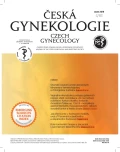Nerozpoznaná preeklampsie, která se rozvinula do eklamptického záchvatu s fatálním koncem
Authors:
R. Matlach 1; P. Makovický 2; P. Makovický 3
Authors‘ workplace:
Katedra zdravotnických oborů a ochrany obyvatelstva, Fakulta biomedicínského inženýrství, ČVUT, Kladno
1; Katedra biológie, Pedagogická fakulta, Univerzita J. Selyeho, Komárno
2; Laboratórium veterinárnej histopatológie, Komárno
3
Published in:
Ceska Gynekol 2018; 83(4): 276-280
Category:
Case Report
Overview
Objective: A fatal case of a 37 year old women in the fifth month of pregnancy, who showed no signs of life and who could not be revived is reported.
Design: Case report.
Settings: Forensic expert in healthcare, Liberec; Department of Health Care Disciplines and Population Protection, Faculty of Biomedical engineering, Czech Technical University in Prague; Department of Biology, Faculty of Education, J. Selye University, Komarno, Slovak republic; Laboratory of Veterinary Histopathology in Komarno, Slovak republic.
Methods: The forensic necropsy was done. Toxicological and histological investigation of sampled material were done.
Results: The autopsy revealed bleeding into the brain chambers. The toxicology results were negative. The histopathological examination showed glomerulonephritis, bloody lungs, and massive bleeding in all sampled organs. From this it was concluded that her dead was caused by unrecognized preeclampsia, which developed into eclamptic attack with fatal consequence.
Conclusion: To avoid these fatalities we recommend that the possibility of preeclampsia is investigated early in pregnancy especially in women with high blood pressure, for whom we also recommend more frequent controls in these early stages of pregnancy. We also recommend more intensive medical care for pregnant women with preeclamptic signs, including the possibility of a shorter schedule of management in specialist care in hospital, from the first symptoms onwards.
Keywords: blood pressure, hypertension, preeclampsia, risk-gravidity
Sources
1. Bainbridge, SA., Roberts, JM. Uric acid as a pathogenic factor in preeclampsia. Placenta, 2008, 29, S67–S72.
2. Bubeníková, Š., Cíchová, A., Roubalová, L., et al. Využití poměru koncentrací solubilního receptoru tyrozinkinázového typu 1 a placentárního růstového faktoru pro krátkodobou predikci a diagnostiku preeklampsie. Čes Gynek, 81, s. 272–278.
3. Cifková, R. Hypertenze v těhotentsví. Vnitřní Lék, 2006, 52, s. 263–270.
4. GBD 2015 Maternal Mortality Collaborators. Global, regional, and national levels of maternal mortality, 1990–2015: a systematic analysis for the Global Burden of Disease Study 2015. Lancet, 2016, 388, 10053, p. 1775–1812.
5. Haško, M., Biringer, K., Biskupská-Boďová, K., Danko J. Vybrané markery v skorej predikcii preeklampsie. Čes Gynek, 2011, 76, s. 135–139.
6. Hornychová, H., Matějková, A., Kacerovský, M. Praktické poznámky k vyšetření placenty ve druhém a třetím trimestru gravidity. Čes Patol, 2015, 51, s. 74–79.
7. Cho, GJ., Kim, LY., Min, KJ., et al. Prior cesarean section is associated with increased preeclampsia risk in a subsequent pregnancy. BMC Pregnancy Childbirth, 2015, 13, p. 15–24.
8. Christian, P., Mullany, LC., Huirley, KM., et al. Nutrition and maternal, neonatal, and child health. Semin Perinatol, 2015, 39, p. 361–372.
9. Christiansen, LR., Collins, KA. Pregnancy-associated deaths? A 15-year retrospective study and overal review of maternal pathophysiology. Am J Forensic Med Pathol, 2006, 27, p. 11–19.
10. Jardim, LL., Rios, DR., Perucci, LO., et al. Is the imbalance between pro-angiogenic and anti-angiogenic factors associated with preeclampsia? Clin Chim Acta, 2015, 447, p. 34–38.
11. Kintiraki, E., Papakatsika, S., Kotronis, G., et al. Pregnancy-induced hypertension. Hormones (Athens), 2015, 14, p. 211–223.
12. Konečná, B., Vlková, B., Celec, P. Role of fetal DNA in preeclampsia (review). Int J Mol Med, 2015, 35, p. 299–304.
13. Měchurová, K., Andělová, K. Hypertenze v graviditě – doporučený postup. Čes Gynek, 2013, S1, 78, s. 45–47.
14. Nikuei, P., Malekzadeh, K., Rajaei, M., et al. The imbalance in expression of angiogenic and anti-angiogenic factors as candidate predictive biomarker in preeclampsia. Iran J Reprod Med, 2015, 13, p. 251–262.
15. Nosková, P., Klozová, R., Bláha, J., et al. Preeklampsie, eklampsie, HELLP syndrom z pohledu anesteziologa. Anest intenziv Med, 2013, 24, p. 350–356.
16. Salustiano, EM., De Pinho, JC., Provost, K., et al. Maternal serum hormonal factors in the pathogenesis of preeclampsia. Obstet Gynecol Surv, 2013, 68, p. 141–150.
17. Srp, B., Velebil, P. Rozbor mateřské úmrtnosti v ČR v roce 2000. Čes Gynek, 2002, 67, s. 268–274.
18. Srp, B., Velebil, P. Rozbor mateřské úmrtnosti v ČR v roce 2001. Čes Gynek, 2005, 70, s. 16–21.
19. Srp, B., Velebil, P., Kvasnička, J. Smrtelné komplikace preeklampsie a eklampsie. Čes Gynek, 2002, 67, s. 365–371.
20. Velebil P. Mateřská úmrtnost ve světě a v ČR. Moderní Gynek Porod, 2010, 19, S4–S7.
Labels
Paediatric gynaecology Gynaecology and obstetrics Reproduction medicineArticle was published in
Czech Gynaecology

2018 Issue 4
Most read in this issue
- Late morbidity in cesarean section scar syndrome
- Implantation and diagnostics of endometrial receptivity
- Zoon vulvitis – a rare form of chronic inflammation of the vulva
- Possibilities and real meaning of assessment of ovarian reserve
